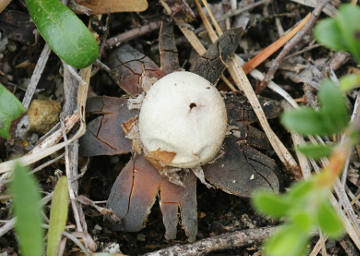

PHOTO COURTESY OF GARRY KESSLER
An earthstar
August 24, 2018, Page A10
NATURE NOTES
By Annie Reid
Westborough Community Land Trust
Earthstars are unique mushrooms
An earthstar? It sounds like the title of a movie or science fiction novel, but no. It’s a mushroom, and not your ordinary mushroom.
Instead of having a cap and a stalk, like most ordinary, familiar mushrooms, an earthstar looks like a ball perched on a star. The ball contains spores which eventually come out of a hole on the top (as usually happens in the mushrooms we know as puffballs), and the star’s arms hold the ball a bit above the ground. From above, the overall appearance is like a star with a big, fat, round center. Have you seen anything like that?
Keep your eyes open for earthstars in sandy areas where the sand isn’t all bare, but rather, is covered with a dark crusty growth or with low sprawling plant life. Earthstars are 1-1/2 to 3 inches across. You might find earthstars lying loose on the surface, but they grow up from below, where the main part of the fungus lives year-round (as with ordinary mushrooms). Underground, the fungus forms relationships with plant roots, and both fungus and plants benefit. Above ground, the earthstars become detached, and wind or rain can move them around, all the better to spread spores.
The entertaining thing about earthstars is how they can respond to weather. When it’s very dry out or when an earthstar has recently come up, the arms of the star are curled up around the ball, as if protecting it. When it’s wet or rainy out, the arms absorb moisture and swell outward, spreading and sometimes raising the ball. There are many different kinds of earthstars throughout the world. In some kinds, the arms swell and open up just once – when the earthstar first comes up – and then remain open, keeping the earthstar as a ball on a star. In other kinds, the arms can open and close over and over again, depending on changes in the weather and humidity. These are often called barometer earthstars. (To see a short video of this action, go to https://blog.mycology.cornell.edu/2014/06/03/twinkly-earthstars/.)
Look for earthstars in sandy areas of powerline cuts or in former sand pits, which exist in our area because the glaciers that once covered the land deposited sand as they melted and retreated northward more than 10,000 years ago. This time of year – August and September – is good for earthstars (and ordinary mushrooms, puffballs, and other fungi), but earthstars don’t break down quickly so you might find them on the ground at any time of year, even in winter. Take care not to walk on dark crusty ground, for the life beginning to grow on the sand there is delicate and easily damaged.
Whether you find an earthstar or not, have fun looking for them – and enjoy the marvelous diversity of life in our local natural environment.